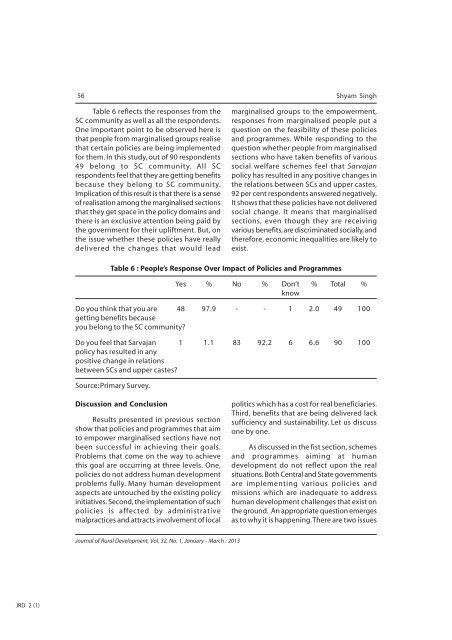January - March 2013 - National Institute of Rural Development
January - March 2013 - National Institute of Rural Development
January - March 2013 - National Institute of Rural Development
- No tags were found...
You also want an ePaper? Increase the reach of your titles
YUMPU automatically turns print PDFs into web optimized ePapers that Google loves.
56 Shyam SinghTable 6 reflects the responses from theSC community as well as all the respondents.One important point to be observed here isthat people from marginalised groups realisethat certain policies are being implementedfor them. In this study, out <strong>of</strong> 90 respondents49 belong to SC community. All SCrespondents feel that they are getting benefitsbecause they belong to SC community.Implication <strong>of</strong> this result is that there is a sense<strong>of</strong> realisation among the marginalised sectionsthat they get space in the policy domains andthere is an exclusive attention being paid bythe government for their upliftment. But, onthe issue whether these policies have reallydelivered the changes that would leadmarginalised groups to the empowerment,responses from marginalised people put aquestion on the feasibility <strong>of</strong> these policiesand programmes. While responding to thequestion whether people from marginalisedsections who have taken benefits <strong>of</strong> varioussocial welfare schemes feel that Sarvajanpolicy has resulted in any positive changes inthe relations between SCs and upper castes,92 per cent respondents answered negatively.It shows that these policies have not deliveredsocial change. It means that marginalisedsections, even though they are receivingvarious benefits, are discriminated socially, andtherefore, economic inequalities are likely toexist.Table 6 : People’s Response Over Impact <strong>of</strong> Policies and ProgrammesYes % No % Don’t % Total %knowDo you think that you are 48 97.9 - - 1 2.0 49 100getting benefits becauseyou belong to the SC community?Do you feel that Sarvajan 1 1.1 83 92.2 6 6.6 90 100policy has resulted in anypositive change in relationsbetween SCs and upper castes?Source: Primary Survey.Discussion and ConclusionResults presented in previous sectionshow that policies and programmes that aimto empower marginalised sections have notbeen successful in achieving their goals.Problems that come on the way to achievethis goal are occurring at three levels. One,policies do not address human developmentproblems fully. Many human developmentaspects are untouched by the existing policyinitiatives. Second, the implementation <strong>of</strong> suchpolicies is affected by administrativemalpractices and attracts involvement <strong>of</strong> localpolitics which has a cost for real beneficiaries.Third, benefits that are being delivered lacksufficiency and sustainability. Let us discussone by one.As discussed in the fist section, schemesand programmes aiming at humandevelopment do not reflect upon the realsituations. Both Central and State governmentsare implementing various policies andmissions which are inadequate to addresshuman development challenges that exist onthe ground. An appropriate question emergesas to why it is happening. There are two issuesJournal <strong>of</strong> <strong>Rural</strong> <strong>Development</strong>, Vol. 32, No. 1, <strong>January</strong> - <strong>March</strong> : <strong>2013</strong>JRD 2 (1)
















